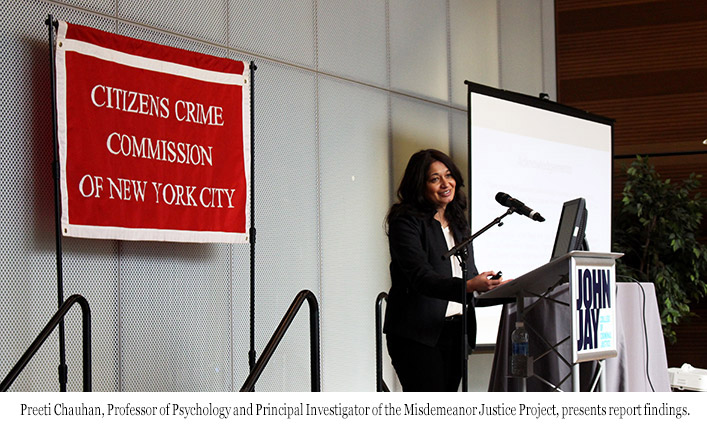
February 1, 2018, New York, NY – The Misdemeanor Justice Project (MJP) at John Jay College of Criminal Justice today released a report that documents striking changes in misdemeanor arrest patterns in New York City over a period of 24 years. The study, Trends in Arrests for Misdemeanor Charges in New York City, 1993-2016, offers an in-depth look at the number and rate of specific charges by demographic groups and borough.
The researchers identified increases in arrest charges that are most likely to be complaint-driven such as victim-related person and property charges in comparison to dramatic fluctuations among charges that are less likely to be complaint-driven, and are more likely to be officer-initiated, such as theft of services, marijuana, and other drug charges. This report also examined seven other individual charge categories such as trespassing and prostitution.
“New York City has seen enormous changes in specific charges categories for misdemeanor arrests. This report highlights the need to disaggregate trends by charges and the importance of using population estimates to examine changes among demographic groups,” said Professor Preeti Chauhan, principal investigator of MJP.
Although misdemeanor arrests almost doubled from 1993 to 2010, arrests for specific misdemeanor charges followed distinctive patterns. The key findings of the report, presented this morning at a forum sponsored by the Citizens Crime Commission of New York City, are as follows.
- From 1993 to 2014, the number of arrests that were more likely to be officer-initiated was higher than complaint-driven arrests. In 2015 and 2016, the number of arrests that were more likely to be complaint-driven exceeded the number of arrests that were more likely to be officer-initiated.
- For all demographic groups, complaint-driven arrests were higher in 2016, relative to 1993.
- For all demographic groups, the number of officer-initiated demonstrated fluctuations and this was more pronounced for men, Blacks, and younger age groups.
- Over the course of the study period, younger people (16-20 year-olds) had higher arrest rates for marijuana and victim-related property charges relative to the oldest age group (35-65 year olds). The older age groups (25-65 year-olds) had higher arrest rates for drugs other than marijuana charges relative to the youngest age groups (16-20 year-olds).

“With this latest report, the Misdemeanor Justice Project once again has demonstrated the power of data analytics to illuminate important trends in policing and criminal justice in New York City,” said Jeremy Travis, Executive Vice President for Criminal Justice at the Laura and John Arnold Foundation. “This report, through careful documentation of the increases and decreases in arrests for low-level misdemeanors, provides the basis for a timely policy discussion on the costs and benefits of these practices. Of particular note are the recent sharp declines in arrests for marijuana and theft of services and the overall increase in arrests for cases involving victims. As this report documents, New York City is experiencing significant – perhaps historic – shifts in enforcement trends that require deeper discussion.”
“This report from the Misdemeanor Justice Project reveals dramatic shifts in enforcement priorities overtime and provides critical insights into how these priorities impact our communities,” said Richard M. Aborn, President of the Citizens Crime Commission of New York City. “As our city continues to have a conversation about improving policing and community relationships and expanding the tools and resources available to address lower level offenses, these data should be an important part of those discussions. I thank John Jay for putting together this insightful study and look forward to working with key stakeholders to improve public safety.”
The complete data analyses are documented in a full report that is available here.
With funding by the Laura and John Arnold Foundation, this is the seventh report prepared by the Misdemeanor Justice Project, a research initiative at John Jay College headed by Professor Chauhan that includes faculty, graduate students and staff. Previous MJP reports have focused on trends in police enforcement practices and trends in corrections including pretrial detention. All reports are part of a series released with the Citizens Crime Commission. To access the MJP reports, please visit the website at www.jjay.cuny.edu/mjp.
About John Jay College of Criminal Justice: An international leader in educating for justice, John Jay College of Criminal Justice of The City University of New York offers a rich liberal arts and professional studies curriculum to upwards of 15,000 undergraduate and graduate students from more than 135 nations. In teaching, scholarship and research, the College approaches justice as an applied art and science in service to society and as an ongoing conversation about fundamental human desires for fairness, equality and the rule of law. For more information, visit www.jjay.cuny.edu.



